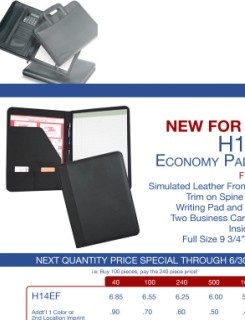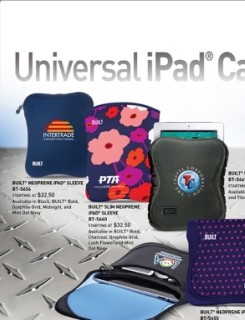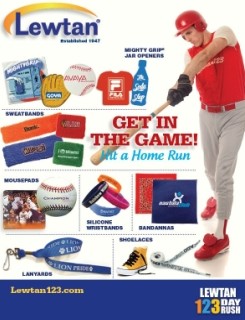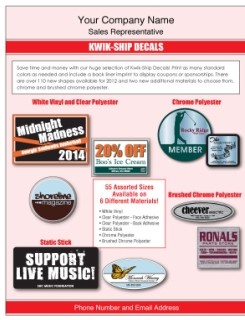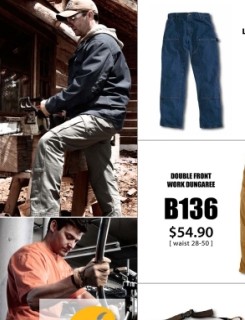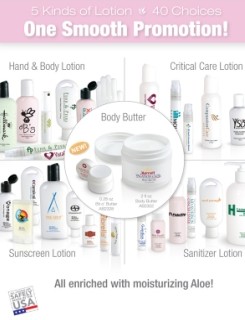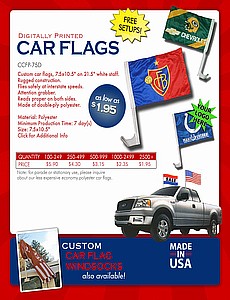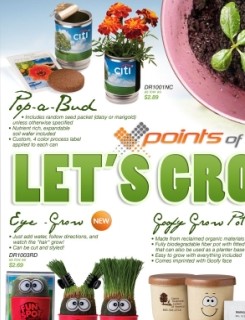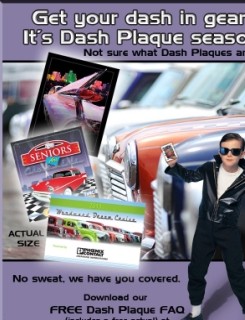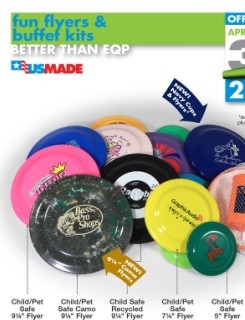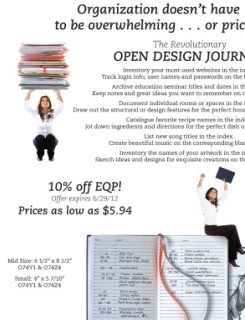Wearables – April/May 2012 : The Rise Of Apparel
The Rise Of Apparel
Christopher Ruvo
Decades ago, promotional T-shirts were a rarity. Now, apparel is the number-one-selling ad specialty item. Industry veterans recall the humble beginnings that took us from there to here.
The pen was mightier than the shirt. That was the state of affairs in the advertising specialties industry in 1982. Writing instruments were king and wearables were a distant fourth, comprising less market share than calendars and business gifts.
but thatwas about to change
within Five years, half of all promotional products distributors were selling apparel and/or accessories, compared to less than 30% in 1983. By 1991, wearables became the industry’s top earner. Twenty years later, wearables account for one out of every three promotional dollars – a staggering total of $6.2 billion in revenue. “Apparel has taken center stage, and the product offerings have really broadened over the last 30 years,” says industry Veteran Duane Watlington, president/CEO of the New Jersey-based distributorship Active Imprints (asi/104863). “Wearables are not going anywhere.”
As Wearables magazine celebrates its 15th anniversary, there’s no better time to examine the humble beginnings of the promotional apparel industry. We asked industry veterans to reflect on the early days and offer insight into how the category has ascended to a place of pride. Here’s what they had to say:
“In 1969, no one knew what to do with wearables. They told me, ‘You’re crazy – no one would ever wear a shirt with someone’s name on it.’” – Max Scharf, Counselor, 2000
The Origins
Ira Neaman, founder/CEO of Vantage Apparel (asi/93390): Max Scharf is believed to have done the industry’s first imprinted T-shirt order of any consequence for Anheuser-Busch. He and I had lunch many years ago, and he told me that back then he had to buy threepacks of white T-shirts from retail stores until he had 1,000 shirts. Then he had red printed on white for the Budweiser shirts, which were a hit. That’s supposedly how the wearables industry was born.
Marty Lott, founder/CEO, SanMar Corporate Apparel, Bags, Hats and Accessories (asi/84863): People have this internal need to belong to groups, and that is what really propelled our industry forward. We have given people the ability to show the groups they belong to through the apparel they wear.
Paula Lavorgna, owner of Newton Screen Printing, Embroidery & Promotional Products (asi/283340): Businesses realized that wearable items presented a great form of advertising. In the early days, some of our best customers were local bars. People wanted to wear shirts with the brand of their local bar. There was a big demand. I’d say to the owner or bartender, “If you sell these T-shirts at cost, you’ve got free advertising.” It’s still true today. It’s why the industry took off.
Bob Kronberger, sales account manager for Geiger (asi/202900): The retail market helped drive the growth, too. People were seeing these things in retail, and everybody wanted a printed T-shirt. There was a lot of potential there.
Ralph Abercrombie, director of merchandising, Atlantic Coast Cotton (asi/37355): In the 1950s, James Dean wore a white T-shirt and it became popular as outerwear. Then in the ’70s you had iconic printed tees like the Farrah Fawcett shirt and the Rolling Stones big lip thing. There were these seminal prints that got everyone’s attention, and suddenly everyone wanted those images on their chest.
Angela Loverdi, owner of Angela Loverdi Graphic Services, a consultancy to the promotional products industry that offers creative graphic designs: Nike and Adidas and other high-end brands started to put their names on T-shirts, and people wore the garments on the outside, not as undershirts. It suddenly became a fashion item. People wanted imprinted merchandise. It really burst open in the ’80s, and this side of the industry started to explode with it. It hasn’t slowed since.
Business AT The Beginning
Today, distributors can select a dizzying array of apparel and accessories from a wide range of suppliers. Innovations in production, along with things like e-mail and computer-based order management systems, have led to lightning- quick fulfillment times. Things were markedly different in the early days.
Mark Stevenson, owner at Proforma Stevenson & Associates (asi/300094): Let’s just say the choices were a lot more limited then, as far as product goes.
Neaman: When I started in 1977, the original products were white and navy 50/50 polo shirts offered with an embroidered logo. That was the full and complete catalog.
Lott: There were a limited number of supplies And a very limited number of companies you could buy them from. From a blank shirt standpoint, it was difficult to keep my warehouse full. There was an expression, “2-4- 4-2,” which meant you had to buy shirts in bunches of two smalls, four mediums, four larges and two extra-larges. Even if I wanted to buy just 100 extra-larges, I couldn’t do it.
Loverdi: It was just the basics: tees, hoodies, crewnecks, a nylon jacket maybe, basic caps. Sometimes you could get a long sleeve. You were limited on color palette; it was mainly primary colors. Availability was always an issue. I’m on the East Coast, and you never purchased from the West Coast because the freighting costs weren’t feasible. If your local Suppliers didn’t have what your client wanted, you’d offer an alternative. People were usually OK with it.
Stevenson: The lead times and the time factor were such that you couldn’t solve problems without healthy advance notice. You’d take orders for the upcoming football season at the beginning of baseball season.
Loverdi: Order-taking was interesting. I worked at a screen-printing shop at the time, and people would come in with an order scribbled on note paper. Sometimes, they’d just walk in and bark out what they wanted. It wasn’t as inefficient as you’d think, though; everyone was very diligent and paying attention.
Abercrombie: Inventory was kept on ledger cards. Pencil hash marks showed how many of a T-shirt we had. How else were you going to do it?
Watlington: You had to manually write orders that you would make copies of, and you’d fill in what style the customer wanted, what sizes, price, etc. You’d have to manually add up the pricing and call suppliers to see what was available; you couldn’t do anything online, Of course. We screen printed in-house in those days, and we’d do our designs in a darkroom. Computer graphics changed all that.
Neaman: A standard order back then took six to eight weeks to fill. There was no FedEx; everything was mail. No cell phones, no voicemail.Still, everybody was comfortable with things taking time then. Gradually, six to eight weeks became five to six weeks, then three to four weeks and so on until now, when we’re in a same-day/next-day service environment.
Apparel’s ascent
By the late ’90s, wearables had truly taken over. In 1997, one in every four promotional products sold was a wearables item. The number of apparel suppliers swelled dramatically, and product offerings expanded well beyond T-shirts and caps to include an array of offerings, like wovens, golf shirts, high-end jackets and polos. Fabric choices ballooned, too, and fabric quality increased, as things like microfi- Ber, high-density polar fleece and Tencel came online. The expansion continues today, with technological advancements powering performancewear innovations and other developments that are making apparel more versatile than ever before.
Abercrombie: As fast as our customers could print on the garments, they were getting more clients and more business. It eventually grew from people wanting shirts for family reunions and prizes and incentives to corporations calling for huge orders of all kinds of logoed wear.
Neaman: The casualization of the workplace, especially in the ’90s, really helped drive growth. You had the emergence of casual Fridays, where employees would wear polo shirts, and companies started wanting to put their names on the shirts. Corporations started to understand the walking billboard concept – that the number of impressions they’d get for the cost made logoed apparel the most costeffective medium
Lott: We started our Port Authority brand in 1991, and that was really a response to casual Friday, to the workplace becoming less formal. You could see the market was going to be huge.
Loverdi: There were greater sales to be had in the wholesale market for promotional sportswear, and there was demand for higherend products. So through the ’80s and ’90s you started to see more suppliers and more products and higher-end brands getting involved.
Watlington: More products and styles became available due to competition. You had one supplier adding a couple of things, so then its competitor came out with more styles to outdo them. It kept going from there.
Stevenson: I really saw all the new styles and different products start to come into play in the early ’90s. The difference then was that everything was domestically made. In the mid-’90s, imports really started to take off.
Neaman: As time went on, the gap between our industry and retail lessened. There used to be a big difference between the two. But now they’re pretty similar to each other. Enduser requirements are more fashion-forward, so you adapt to that.
Lavorgna: The number of SKUs has just exploded. When we started, we used Hanes T-shirts and Fruit of the Loom T-shirts, and that was it. There were two different crewneck sweatshirts. Now, there are six different weights and four different combinations of cotton and polyester. Decorating techniques Have really expanded, too.
Kronberger: You started to have all the women’s styles become available. It used to be there were either no ladies’ styles or very limited styles. But in the ’90s it started heaviest with pieces for women. Now it’s very unusual to come out with styles that are not available for both men and ladies.
Abercrombie: When I started, there weren’t men’s and women’s; there was just “adult.” That’s what it was called. Now our catalogs have special ladies’ sections; it’s taken for granted that if you have a men’s size, you’re going to have a ladies’ to go with it.
Stevenson: As you had more products and more competition and the technology come into play, selling changed. It became much more professional. Because of the tools we have and all the product solutions at our fingertips, we can be better problem-solvers for our clients.
The Years ahead
Lott: Going forward, I think there’s going to be more variety of product. We’re producing better products that will last longer. Value is going to increase.
Stevenson: I see a lot of market blending. I see markets like sporting goods and promotional products blending together because people want a one-stop solution; they want their promotional products distributor to be an expert in fit and fabrics for apparel. You’ll Always have to keep up your expertise.
Watlington: The industry definitely isn’t going away. To be competitive, you need to stay on top of retail and fashion trends. See what the kids are buying at the malls, both for style and graphics, because we’re following retail more closely than ever.
Lavorgna: I think there’s going to be a consolidation, and that it’s going to be harder to be a middle-sized business.
Loverdi: We’re going to see a trend where people value quality more, where it’s less about price. I think you’ll see people wanting more American-made products.
Neaman: There’s always going to be food, shelter and clothing. People have a human need for affiliation and being part of a group, yet they also want to be unique and individual.
They like to identify with their companies, teams, organizations, groups, causes. Imprinted apparel allows them to do that, yet also be unique, so it’s the best of both worlds.
Christopher Ruvo is a staff writer for Wearables
Learn it Live!
The pen was mightier than the shirt. That was the state of affairs in the advertising specialties industry in 1982. Writing instruments were king and wearables were a distant fourth, comprising less market share than calendars and business gifts.
but thatwas about to change
within Five years, half of all promotional products distributors were selling apparel and/or accessories, compared to less than 30% in 1983. By 1991, wearables became the industry’s top earner. Twenty years later, wearables account for one out of every three promotional dollars – a staggering total of $6.2 billion in revenue. “Apparel has taken center stage, and the product offerings have really broadened over the last 30 years,” says industry Veteran Duane Watlington, president/CEO of the New Jersey-based distributorship Active Imprints (asi/104863). “Wearables are not going anywhere.”
As Wearables magazine celebrates its 15th anniversary, there’s no better time to examine the humble beginnings of the promotional apparel industry. We asked industry veterans to reflect on the early days and offer insight into how the category has ascended to a place of pride. Here’s what they had to say:
“In 1969, no one knew what to do with wearables. They told me, ‘You’re crazy – no one would ever wear a shirt with someone’s name on it.’” – Max Scharf, Counselor, 2000
The Origins
Ira Neaman, founder/CEO of Vantage Apparel (asi/93390): Max Scharf is believed to have done the industry’s first imprinted T-shirt order of any consequence for Anheuser-Busch. He and I had lunch many years ago, and he told me that back then he had to buy threepacks of white T-shirts from retail stores until he had 1,000 shirts. Then he had red printed on white for the Budweiser shirts, which were a hit. That’s supposedly how the wearables industry was born.
Marty Lott, founder/CEO, SanMar Corporate Apparel, Bags, Hats and Accessories (asi/84863): People have this internal need to belong to groups, and that is what really propelled our industry forward. We have given people the ability to show the groups they belong to through the apparel they wear.
Paula Lavorgna, owner of Newton Screen Printing, Embroidery & Promotional Products (asi/283340): Businesses realized that wearable items presented a great form of advertising. In the early days, some of our best customers were local bars. People wanted to wear shirts with the brand of their local bar. There was a big demand. I’d say to the owner or bartender, “If you sell these T-shirts at cost, you’ve got free advertising.” It’s still true today. It’s why the industry took off.
Bob Kronberger, sales account manager for Geiger (asi/202900): The retail market helped drive the growth, too. People were seeing these things in retail, and everybody wanted a printed T-shirt. There was a lot of potential there.
Ralph Abercrombie, director of merchandising, Atlantic Coast Cotton (asi/37355): In the 1950s, James Dean wore a white T-shirt and it became popular as outerwear. Then in the ’70s you had iconic printed tees like the Farrah Fawcett shirt and the Rolling Stones big lip thing. There were these seminal prints that got everyone’s attention, and suddenly everyone wanted those images on their chest.
Angela Loverdi, owner of Angela Loverdi Graphic Services, a consultancy to the promotional products industry that offers creative graphic designs: Nike and Adidas and other high-end brands started to put their names on T-shirts, and people wore the garments on the outside, not as undershirts. It suddenly became a fashion item. People wanted imprinted merchandise. It really burst open in the ’80s, and this side of the industry started to explode with it. It hasn’t slowed since.
Business AT The Beginning
Today, distributors can select a dizzying array of apparel and accessories from a wide range of suppliers. Innovations in production, along with things like e-mail and computer-based order management systems, have led to lightning- quick fulfillment times. Things were markedly different in the early days.
Mark Stevenson, owner at Proforma Stevenson & Associates (asi/300094): Let’s just say the choices were a lot more limited then, as far as product goes.
Neaman: When I started in 1977, the original products were white and navy 50/50 polo shirts offered with an embroidered logo. That was the full and complete catalog.
Lott: There were a limited number of supplies And a very limited number of companies you could buy them from. From a blank shirt standpoint, it was difficult to keep my warehouse full. There was an expression, “2-4- 4-2,” which meant you had to buy shirts in bunches of two smalls, four mediums, four larges and two extra-larges. Even if I wanted to buy just 100 extra-larges, I couldn’t do it.
Loverdi: It was just the basics: tees, hoodies, crewnecks, a nylon jacket maybe, basic caps. Sometimes you could get a long sleeve. You were limited on color palette; it was mainly primary colors. Availability was always an issue. I’m on the East Coast, and you never purchased from the West Coast because the freighting costs weren’t feasible. If your local Suppliers didn’t have what your client wanted, you’d offer an alternative. People were usually OK with it.
Stevenson: The lead times and the time factor were such that you couldn’t solve problems without healthy advance notice. You’d take orders for the upcoming football season at the beginning of baseball season.
Loverdi: Order-taking was interesting. I worked at a screen-printing shop at the time, and people would come in with an order scribbled on note paper. Sometimes, they’d just walk in and bark out what they wanted. It wasn’t as inefficient as you’d think, though; everyone was very diligent and paying attention.
Abercrombie: Inventory was kept on ledger cards. Pencil hash marks showed how many of a T-shirt we had. How else were you going to do it?
Watlington: You had to manually write orders that you would make copies of, and you’d fill in what style the customer wanted, what sizes, price, etc. You’d have to manually add up the pricing and call suppliers to see what was available; you couldn’t do anything online, Of course. We screen printed in-house in those days, and we’d do our designs in a darkroom. Computer graphics changed all that.
Neaman: A standard order back then took six to eight weeks to fill. There was no FedEx; everything was mail. No cell phones, no voicemail.Still, everybody was comfortable with things taking time then. Gradually, six to eight weeks became five to six weeks, then three to four weeks and so on until now, when we’re in a same-day/next-day service environment.
Apparel’s ascent
By the late ’90s, wearables had truly taken over. In 1997, one in every four promotional products sold was a wearables item. The number of apparel suppliers swelled dramatically, and product offerings expanded well beyond T-shirts and caps to include an array of offerings, like wovens, golf shirts, high-end jackets and polos. Fabric choices ballooned, too, and fabric quality increased, as things like microfi- Ber, high-density polar fleece and Tencel came online. The expansion continues today, with technological advancements powering performancewear innovations and other developments that are making apparel more versatile than ever before.
Abercrombie: As fast as our customers could print on the garments, they were getting more clients and more business. It eventually grew from people wanting shirts for family reunions and prizes and incentives to corporations calling for huge orders of all kinds of logoed wear.
Neaman: The casualization of the workplace, especially in the ’90s, really helped drive growth. You had the emergence of casual Fridays, where employees would wear polo shirts, and companies started wanting to put their names on the shirts. Corporations started to understand the walking billboard concept – that the number of impressions they’d get for the cost made logoed apparel the most costeffective medium
Lott: We started our Port Authority brand in 1991, and that was really a response to casual Friday, to the workplace becoming less formal. You could see the market was going to be huge.
Loverdi: There were greater sales to be had in the wholesale market for promotional sportswear, and there was demand for higherend products. So through the ’80s and ’90s you started to see more suppliers and more products and higher-end brands getting involved.
Watlington: More products and styles became available due to competition. You had one supplier adding a couple of things, so then its competitor came out with more styles to outdo them. It kept going from there.
Stevenson: I really saw all the new styles and different products start to come into play in the early ’90s. The difference then was that everything was domestically made. In the mid-’90s, imports really started to take off.
Neaman: As time went on, the gap between our industry and retail lessened. There used to be a big difference between the two. But now they’re pretty similar to each other. Enduser requirements are more fashion-forward, so you adapt to that.
Lavorgna: The number of SKUs has just exploded. When we started, we used Hanes T-shirts and Fruit of the Loom T-shirts, and that was it. There were two different crewneck sweatshirts. Now, there are six different weights and four different combinations of cotton and polyester. Decorating techniques Have really expanded, too.
Kronberger: You started to have all the women’s styles become available. It used to be there were either no ladies’ styles or very limited styles. But in the ’90s it started heaviest with pieces for women. Now it’s very unusual to come out with styles that are not available for both men and ladies.
Abercrombie: When I started, there weren’t men’s and women’s; there was just “adult.” That’s what it was called. Now our catalogs have special ladies’ sections; it’s taken for granted that if you have a men’s size, you’re going to have a ladies’ to go with it.
Stevenson: As you had more products and more competition and the technology come into play, selling changed. It became much more professional. Because of the tools we have and all the product solutions at our fingertips, we can be better problem-solvers for our clients.
The Years ahead
Lott: Going forward, I think there’s going to be more variety of product. We’re producing better products that will last longer. Value is going to increase.
Stevenson: I see a lot of market blending. I see markets like sporting goods and promotional products blending together because people want a one-stop solution; they want their promotional products distributor to be an expert in fit and fabrics for apparel. You’ll Always have to keep up your expertise.
Watlington: The industry definitely isn’t going away. To be competitive, you need to stay on top of retail and fashion trends. See what the kids are buying at the malls, both for style and graphics, because we’re following retail more closely than ever.
Lavorgna: I think there’s going to be a consolidation, and that it’s going to be harder to be a middle-sized business.
Loverdi: We’re going to see a trend where people value quality more, where it’s less about price. I think you’ll see people wanting more American-made products.
Neaman: There’s always going to be food, shelter and clothing. People have a human need for affiliation and being part of a group, yet they also want to be unique and individual.
They like to identify with their companies, teams, organizations, groups, causes. Imprinted apparel allows them to do that, yet also be unique, so it’s the best of both worlds.
Christopher Ruvo is a staff writer for Wearables
Learn it Live!











